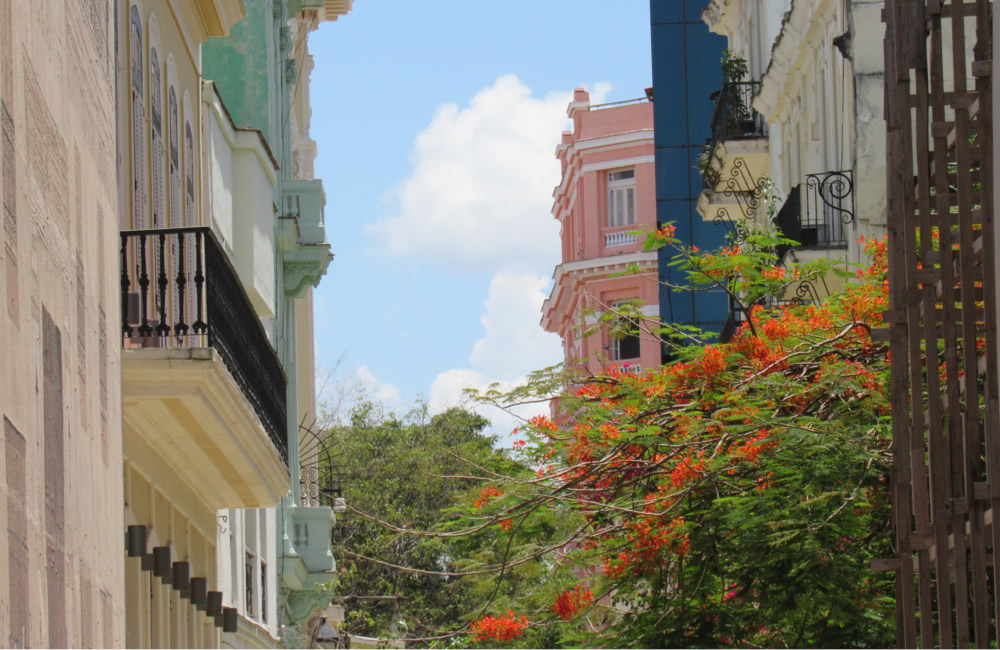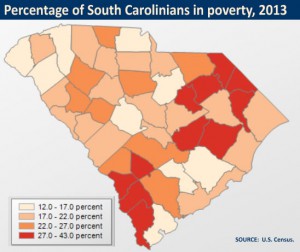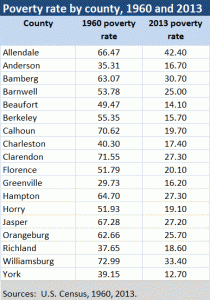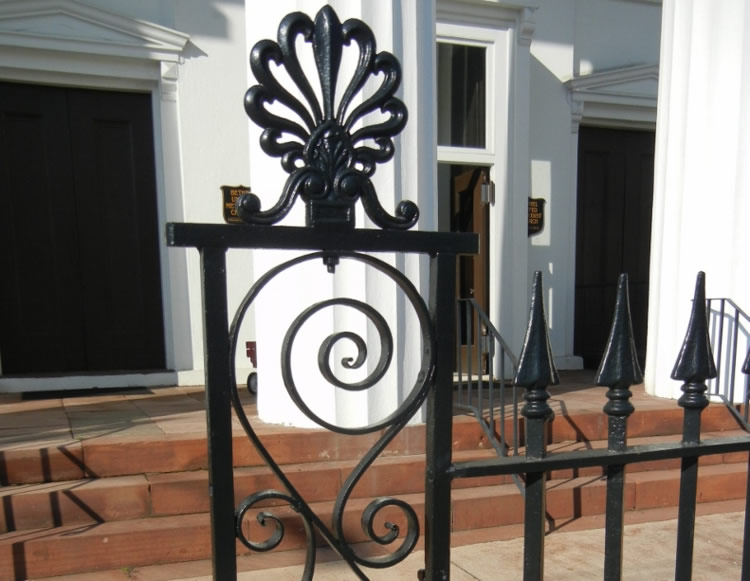 Charleston or New Orleans? Nah, this is a picture from old Havana. The big giveaway is the flamboyant tree, covered in bright red flowers. The tree will grow here but has a tough time getting this large because of the winter weather. But it’s all over the place in Cuba. This photo is just one of 14 in a new Photo Essay by editor and publisher Andy Brack on the buildings of Cuba. Check it out.
Charleston or New Orleans? Nah, this is a picture from old Havana. The big giveaway is the flamboyant tree, covered in bright red flowers. The tree will grow here but has a tough time getting this large because of the winter weather. But it’s all over the place in Cuba. This photo is just one of 14 in a new Photo Essay by editor and publisher Andy Brack on the buildings of Cuba. Check it out.
IN THIS ISSUE
PHOTO ESSAY: The buildings of Cuba
FOCUS, Ginny Deerin: Will work to relieve traffic congestion as mayor
BRACK: Mr. Fixit strikes again
IN THE SPOTLIGHT: Magnolia Plantation and Gardens
REAL ESTATE: Understanding the cyclical nature of our market
GOOD NEWS: Not as poor, but poverty still persists; more
FEEDBACK: CCC article brings back memories
CALENDAR, Sept. 21+: Author visit, diversity meeting, Oktoberfest, Ball Fall
MYSTERY: Not a pearly gate
S.C. ENCYCLOPEDIA: The Rev. John Martin Pike
TODAY’S FOCUS
FOCUS: Will work to relieve traffic congestion as mayor
By Ginny Deerin, candidate for mayor of Charleston
SEPT. 21, 2015 | Many days, it feels like we spend more time trying to get places than actually being there.
It should not be this hard to get around Charleston. As mayor, I will work day-and-night to relieve traffic congestion — and make it easier to get where we are going.
We can do better. We have studied our traffic problems to death. Now is the time for action. I have presented a bold and aggressive transportation action plan — a plan that includes clear and identifiable funding streams.
My plan, “Accelerate Charleston,” calls for a strong emphasis on improving Charleston’s roads to decrease congestion. By better connecting neighborhoods and building and improving local roads, drivers will have more than one way to get on and off main arteries.
There are broader measures we can take too – none of which are rocket science. When new development is planned, traffic infrastructure must be in place before the project is complete — not as an afterthought once we are all stuck in traffic.
In addition, by constructing 50 miles of sidewalks, pathways and bikeways by 2018, residents will be less likely to rely on a car for every trip.
Trying new things will enable us to set the standard for world-class transportation. Connecting the peninsula with West Ashley and Daniel Island by piloting a ferry system across our beautiful waterways will shorten commutes and get cars off the roads. Employing the latest technology will make parking faster for drivers – and residents must be able to park near their homes.
We can also bring modern buses to Charleston, and equip them with wireless internet and smart traffic signal sensors. This technology would allow for traffic lights to remain green for longer when an approaching bus is detected. By piloting routes between high-density points, riders can get to their destinations faster and be more productive on the way. That would make public transportation a more viable option for more commuters.
 Failure to act is not an option. Bad roads are personally costing drivers an average of $1,200 each year in extra maintenance, gas and lost time from traffic congestion. The Charleston Metro Chamber of Commerce reported that South Carolina was ranked the second deadliest place to drive in the United States.
Failure to act is not an option. Bad roads are personally costing drivers an average of $1,200 each year in extra maintenance, gas and lost time from traffic congestion. The Charleston Metro Chamber of Commerce reported that South Carolina was ranked the second deadliest place to drive in the United States.
Every part of my plan is doable – and has worked elsewhere.
No leader can do this alone. A mayor with a reputation of bringing people together can also bring regional leaders together, and activate citizens to demand real solutions. Revenue strategies that funded transportation projects in other cities can be used here too, like public-private partnerships, philanthropy, and obtainable federal resources.
The missing piece is political will – and it will take individuals frustrated with traffic, parking, and mobility overall organizing to change that.
The governor and state legislature are responsible for some of our frustrations by repeatedly failing to pass a transportation infrastructure bill, despite it having broad support. Both the House and Senate bills called for a slight increase in the gas tax – which is supported by The Post and Courier, Chamber of Commerce, AARP and others. A responsible and sustainable transportation infrastructure bill is in Charleston’s best interest. Not passing one is reckless and shortsighted.
Traffic hurts our quality of life. It prevents us from spending time with our families and from being productive at work. Bad roads also become an unnecessary obstacle in moving goods across our state, which could make us less competitive economically.
I will use every formal and informal tool available to the Mayor to improve our roads and highways to relieve traffic.
Politicians ask us for patience but I’ve used all mine up looking for parking and being stuck in traffic. Without taking real action, our transportation infrastructure will further deteriorate, our traffic problems will worsen, and our quality of life and economy will suffer.
So, I am staking my candidacy for mayor on offering real and thoughtful solutions to problems we face. Traffic congestion is a natural result of growth, but getting around Charleston should not be this difficult. No silver bullet will solve all our transportation needs, but we can make it easier to get around by taking a comprehensive approach that is bold and aggressive.
Ginny Deerin, a candidate for mayor of Charleston, is the founder and former CEO of WINGS for Kids. Learn more about her campaign here: GinnyForMayor.com.
EDITOR’S NOTE: Charleston Currents has offered this space to each of the Charleston mayoral candidates to share their views with readers. Click the “2015 Election” tab at top to see pieces by William Dudley Gregorie, Maurice Washington, Toby Smith and Leon Stavrinakis. Next week is the last installment by John Tecklenburg.
COMMENTARYMr. Fixit strikes in Charleston
By Andy Brack, editor and publisher
SEPT. 21, 2015 | Years back when my father was a boy, he knew his father could fix just about anything. He marveled at his father’s skills, not understanding how he would ever be able to build shelves, craft furniture, fix electrical outlets or repair motors.
![]() Only years later — maybe when I was asking my dad how he knew how to fix stuff — did he understand that with age comes experience. He recalls how when he was gazing at his dad fixing stuff, his dad had been on the earth several years and had gained knowledge over time about how to use tools correctly. As a boy, he didn’t understand that learning to repair stuff took time and wasn’t a miracle. As an adult, he understood that he gained knowledge over years to become more comfortable with mending things around the house.
Only years later — maybe when I was asking my dad how he knew how to fix stuff — did he understand that with age comes experience. He recalls how when he was gazing at his dad fixing stuff, his dad had been on the earth several years and had gained knowledge over time about how to use tools correctly. As a boy, he didn’t understand that learning to repair stuff took time and wasn’t a miracle. As an adult, he understood that he gained knowledge over years to become more comfortable with mending things around the house.
 Unlike my grandfather, I’ve never been blessed with great mechanical skills. But over the last week, I’ve been kind of stunned at the things that have been improved or fixed around the house:
Unlike my grandfather, I’ve never been blessed with great mechanical skills. But over the last week, I’ve been kind of stunned at the things that have been improved or fixed around the house:
- Installed 16 gigabytes of RAM to increase the speed of my desktop computer;
- Opened a stuck drawer in the laundry area (without breaking it) where the detergent is stored;
- Replaced a broken fountain pump, including repairing the damaged intake hose;
- Replaced a non-functioning, out-of-the-way spotlight in the kitchen with an energy-efficient LED bulb;
- Created a filter from parts for an aquarium;
- Reattached a wooden threshold that had become unglued;
- Prepared a winter salad garden and planted cabbage and lettuces; and
- Smoked four pounds of pork into some of the best barbecue that I’ve eaten lately. (Yes, I saved the best for last.)
Twenty years ago, I might not have been able to do a good job at some of these things. But with age, as I now understand as did my father before, comes the experience to solve little problems.
* * * * *
My most recent policy column in our sister publication, Statehouse Report, exposes how Gov. Nikki Haley put the state Department of Health and Environmental Control between a rock and hard place over a probe of abortion clinics.
The whole brouhaha was a strategy by Haley to look more conservative to GOP presidential hopefuls, especially since she self-professed that she wouldn’t turn down anyone who talked to her about being a GOP vice presidential running mate. She’s going after clinics because conservative credentials suffered after she rightly dumped the Confederate flag from the Statehouse grounds. In fact, that pushed up her poll numbers among Democrats and blacks.
So while I figured Charleston Currents’ readers would prefer to hear about Mr. Fixit than a rant about the governor’s tactics, here’s an excerpt (or you can click here for the full column):
“Yes, to get headlines, Haley used DHEC, whose board she appoints. But it didn’t turn out exactly how she wanted. Instead of a big press conference about the findings, DHEC quietly released the information at one of the slowest times of the week for the media — Friday afternoon, when most reporters are finishing stories they’ve worked on for a week.
“What’s important to take away are three things:
- None of the violations cited by DHEC directly put any women or their health at risk. But anything not up to snuff — even minor paperwork problems — need to be brought into compliance. The law is the law.
- Thousands of dedicated DHEC employees have been embarrassed because the agency was dragged through the muck because of politics.
- This incident is a prime example of how the passions of South Carolinians are being manipulated by a hyper-ambitious governor who wants to score points in a much larger political game.”
Andy Brack is editor and publisher of Charleston Currents and Statehouse Report. You can reach him at: editor@charlestoncurrents.com
IN THE SPOTLIGHTMagnolia Plantation and Gardens
 The public spiritedness of our underwriters allows us to bring Charleston Currents to you at no cost. Today we shine our spotlight on Magnolia Plantation and Gardens, founded in 1676 by the Drayton family. It has survived the centuries and witnessed the history of our nation unfold before it from the American Revolution through the Civil War and beyond. It is the oldest public tourist site in the Lowcountry and the oldest public gardens in America, opening its doors to visitors in 1870. Open 365 days a year, Magnolia offers its visitors splendid tours of nature and history and the role African-Americans played in the development of its award-winning Romantic-style gardens.
The public spiritedness of our underwriters allows us to bring Charleston Currents to you at no cost. Today we shine our spotlight on Magnolia Plantation and Gardens, founded in 1676 by the Drayton family. It has survived the centuries and witnessed the history of our nation unfold before it from the American Revolution through the Civil War and beyond. It is the oldest public tourist site in the Lowcountry and the oldest public gardens in America, opening its doors to visitors in 1870. Open 365 days a year, Magnolia offers its visitors splendid tours of nature and history and the role African-Americans played in the development of its award-winning Romantic-style gardens.
- Visit www.magnoliaplantation.com to learn how you can experience a complete plantation experience.
Understanding the cyclical nature of our market
By Doug Holmes, contributing editor
SEPT. 21, 2015 | I had several people come up to me last week and ask me about a recent article they had read about local real estate activity in the local newspaper. They were concerned that the market here might be losing steam.
 The article in the local paper had done a great job at misleading them. They had published that buying activity here in Charleston had experienced a steep decline over the past month. While that is somewhat true, that same article can be printed every September and another one can be printed every October, November and December.
The article in the local paper had done a great job at misleading them. They had published that buying activity here in Charleston had experienced a steep decline over the past month. While that is somewhat true, that same article can be printed every September and another one can be printed every October, November and December.
You have to understand that our market, as are most real estate markets, is cyclical within the year. Buying activity is at its highest in the spring and summer, March though August. April and May are usually the busiest months. Then, each year, there is a slight tapering off in activity each month from September through the following January or February. But you also have to understand the newspaper’s point of view. Explaining all the facts is not nearly so eye-catching.
What is more important is how this August did, compared to last August. August is always going to be slower than July. And each month after August will be worse than the preceding month in reference to buying activity. So, it turns out that this August was better than August 2014. It was only up 1.1 percent in terms of the number of sales. But that’s not a headline that’s going to grab readers’ attentions. So, the local newspaper decided to focus on a much larger percentage, the comparison of August to July.
 The method that I use weekly to keep up with buying activity is to look at how many properties go under contract each week. And I correctly compare this to the same week from the previous years. I’ve mentioned this in these articles before.
The method that I use weekly to keep up with buying activity is to look at how many properties go under contract each week. And I correctly compare this to the same week from the previous years. I’ve mentioned this in these articles before.
Any time that we see more than 200 properties go under contract in the Charleston area in a week, we know we’ve had a good week. Anything over 300 is phenomenal. From 2008 to 2010, we hardly had any weeks go over 200. 2011 had a few more weeks over 200. In 2012, you could really tell things picked up when the vast majority of the weeks were over 200. But we didn’t get weeks over 300 again, like in the 2004 to2006 period, until 2013.
2014 was a little better when 21 weeks had over 300 and our market was really gaining momentum. In 2015, almost every week has been over 300 and we even had four weeks over 400, something we’d never seen before.
Now, this past week was the first under 300 since January. But it was to be expected. It’s that time of year. There’s nothing to be alarmed about. Sales will continue to slow slightly until next February. This happens every year. I guess, the local newspaper will expect you to be shocked when Christmas comes in December again this year.
Doug Holmes is a local Realtor with Keller Williams. He also provides markets analysis for a fee to several hundred local real estate agents. He has a bachelor’s degree in physics and math from the College of Charleston as well as a master’s degree in math from the college, where he still teaches a couple of statistics classes in the fall. Visit his website here.
GOOD NEWSWe’re not as poor, but there’s still a lot of poverty
Staff reports | The South isn’t as mired in poverty as it once was, according to a new report, and South Carolina is no exception. But in many places in the Palmetto State, things still aren’t that great.
Before President Lyndon Johnson launched his War on Poverty campaign, the South was home to 49 percent of the nation’s poor, according to Pew Research. Today, the region is home to 41 percent of the nation’s poor. But what’s striking is how poverty overall is far different throughout the South.
 Back in 1960, some 35.6 percent of Southerners lived in poverty, compared to 16.4 percent today, the report said. South Carolina is no different. In 1960, 45.4 percent of South Carolinians lived in poverty, according to census information. Today, 18.5 percent of people in the Palmetto State live at or below the poverty level.
Back in 1960, some 35.6 percent of Southerners lived in poverty, compared to 16.4 percent today, the report said. South Carolina is no different. In 1960, 45.4 percent of South Carolinians lived in poverty, according to census information. Today, 18.5 percent of people in the Palmetto State live at or below the poverty level.
Nationally, poverty has shifted from a more rural occurrence to a more urban one, the Pew report said. But that’s not the case in South Carolina. The chart below of selected counties illustrates how poverty fell across the board in South Carolina’s counties, but rates tend to be much lower in urban counties or in neighboring suburban counties.
 Case in point: Calhoun County, once a rural mainstay that now more of a suburban county wedged between larger communities of Columbia and Orangeburg. Back in 1960, Calhoun County had a 70.6 percent poverty rate. Today? It’s still high, but is 19.7 percent.
Case in point: Calhoun County, once a rural mainstay that now more of a suburban county wedged between larger communities of Columbia and Orangeburg. Back in 1960, Calhoun County had a 70.6 percent poverty rate. Today? It’s still high, but is 19.7 percent.
Coastal counties that have gotten huge influxes of tourism and growth also had big drops — 51.9 percent (1960) to 19.1 percent (2013) for Horry County. Beaufort County went from 49.5 percent poverty in 1960 to 14.1 percent in 2013. Charleston County dropped from 40 percent to 17.4 percent.
But the story hasn’t changed much in places like Allendale County. In 1960, two in three people lived in poverty. In 2013, 42.4 percent of its residents lived below the poverty level. Today, it’s one of the most impoverished counties in the nation.
Across the state, some 35 of 46 counties today have poverty rates above South Carolina’s already higher-than-national poverty rate of 18.5 percent. The eleven counties with the lowest rates: All urban or suburban.
- Sources: 1960 Census information | 2013 Census data
In other news briefs:
“America After Charleston” to air today, Thursday. SCETV is co-producer of this national program, a town hall meeting being recorded Saturday in Charleston, that explores the many issues propelled into public discourse after the tragic June shooting of nine worshippers at Emanuel AME Church in Charleston. The News Hour’s Gwen Ifill is moderator. The show airs Sept. 21 at 9 p.m. in ETV and is repeated at 8:30 p.m. Sept. 24 on the South Carolina Channel.
Luster wins 1858 Prize for Contemporary South. New Orleans photographer Deborah Luster is the winner of this annual $10,000 prize by the Gibbes Museum of Art and Society 1858 that acknowledges “the highest level of artistic achievement in any media while contributing to a new understanding of art in the South.”
“Deborah is an incredibly gifted photographer and a powerful storyteller. Her portraits of inmates in the Louisiana prison system are heartbreaking and beautiful at the same time. Her work has real purpose,” says Curator of Exhibitions, Pam Wall.
More than 275 artists entered the annual competition. Luster’s recent body of work, Tooth for an Eye, captures desolate landscapes in New Orleans where murders have occurred. A selection of photographs from this series will be featured in the upcoming Gibbes exhibition The Things We Carry: Contemporary Art in the South, scheduled to open in the spring of 2016.
Conservancy seeks input for park renovation. In an effort to improve a well-used park on the upper peninsula, the Charleston Parks Conservancy, in partnership with the City of Charleston and the Eastside community, is planning a renovation and playground upgrade for St. Julian Devine Center Park, according to a news release.
The public is invited to a project workshop on Sept. 23 where they can view proposed plans and share their own ideas for playground and park enhancements. The workshop begins at 9 a.m. with a kickoff presentation, with workshops throughout the day, and an evening session for public input and feedback. Located at 1 Cooper St., the St. Julian Devine Community Center is located in an historic industrial building, renovated and repurposed in the 1970s as a civic building. Today, the center and surrounding park serve as an educational and recreational space managed by the city’s Recreation Department. It is one of a small number of public facilities that serves the diverse communities of Charleston’s upper peninsula.
FEEDBACKCCC article brought back great memories
To the editor:
I believe I am one of the fortunate ones to have received the very first issue of Charleston Currents. While I always learn something new, never has an article resonated as much as the one on the Civilian Conservation Corps.
 My father, Art Goldsmith, was a recent high school graduate living in Collinsville, Okla., when the Dust Bowl hit. The family dry goods store wasn’t very successful to begin with; it quickly went downhill. There was no future for a healthy young man other than to go into the CCC and send money back home.
My father, Art Goldsmith, was a recent high school graduate living in Collinsville, Okla., when the Dust Bowl hit. The family dry goods store wasn’t very successful to begin with; it quickly went downhill. There was no future for a healthy young man other than to go into the CCC and send money back home.
For my father, the camp was in Arkansas. Like so many faced with unpleasant situations and difficult choices, he never spoke about his experiences. He just did what he had to do. Nonetheless, it is easy to imagine his projects paralleled those in South Carolina. Undoubtedly the Arkansas park system, roads and trails, fire towers, and reforestation projects have men like my father to thank.
My father worked his way through Arkansas and back to Chicago where he had been born. There was still family living there and a greater chance for employment. As a bonus, he would find his future wife and settle to raise his family. But the CCC was an integral part of his life and became part of my legacy.
Among my favorite hats is the one he wore as a member of the Corps and the one he wore as a Jewish war veteran. He was a genuine product of his times and member of the greatest generation.
— His proud daughter, Archie Burkel, James Island
Rant. Rave. Tell us what you really think. If you have an opinion on something we’ve offered or on a subject related to the Lowcountry, please send your letters of 150 words or less to: editor@charlestoncurrents.com. Our feedback policy.
CALENDARSept. 21+: Author visit, diversity meeting, Oktoberfest, Ball Fall
 Author visit: 5 p.m., Sept. 21, Blue Bicycle Books, 420 King St., Charleston. Author Lee Robinson will read from her debut novel, “Lawyer for the Dog,” which is set in Charleston where she worked for years as a lawyer and was the first woman president of the Charleston County Bar Association. She now lives in Texas. More: BlueBicycleBooks.com
Author visit: 5 p.m., Sept. 21, Blue Bicycle Books, 420 King St., Charleston. Author Lee Robinson will read from her debut novel, “Lawyer for the Dog,” which is set in Charleston where she worked for years as a lawyer and was the first woman president of the Charleston County Bar Association. She now lives in Texas. More: BlueBicycleBooks.com
Workplace diversity: 9 a.m. to 4 p.m., Sept. 25, School of Professional Studies, College of Charleston, 3800 Paramount Road, North Charleston. The College of Charleston, The Citadel, MUSC and Denny’s are partners in a new, day-long initiative to bring together community leaders to advance the management of diversity. Register: go.cofc.edu/advancingdiversity
Chase After a Cure golf tournament: Sept. 25, Patriots Point Links, Mount Pleasant. The fourth annual Drive Away Childhood Cancer Golf Tournament will benefit Chase After a Cure, a Summerville nonprofit that funds childhood cancer research and raises awareness. Since 2009, the group has raised almost $1 million for research and equipment at MUSC. $400 a foursome. More info: http://www.chaseafteracure.com
Oktoberfest 5K Run-Walk: 9 a.m., Sept. 26, Laurel Hill County Park, Mount Pleasant. The East Cooper Breakfast Rotary Club will host this annual benefit trail run that features a German band, brats and a Bavarian beer garden to welcome participants to the finish line. Costumes encouraged. Learn more and register here: http://oktoberfest5k.net/
Ball Fall: 3 p.m. to 6 p.m., Sept. 27, Awendaw Green at Sewee Outpost, 4853 Highway 17 North, Awendaw. All ages are welcome for this annual event benefiting East Cooper Meals on Wheels. The spotlight event is a golf ball drop from a ladder fire truck. Whichever ball ends closes to a target could win $1,000 for its owner. Music, barbecue competition, corn hole, more. Free admission for adults with one $10 balls sponsorship. More info.
(NEW) Charleston Greek Fall Festival: Oct. 2-4, Greek Orthodox Church of the Holy Trinity, 30 Race St., Charleston. Join a celebration of Greek faith, culture, food, wine and music at this annual tradition. Free for active-duty military and kids under 13. Just $3 for seniors and students; $5 for adults. More.
PURE Theatre show: Through Oct. 2, 477 King Street, Charleston. The theatre will offer the southeastern regional premier of Gina Gionfriddo’s critically-acclaimed comedy, “Rapture, Blister, Burn,” at 3 p.m. or 7:30 p.m. (check the website for more details).
(NEW) Thanks Joe! 3 p.m. to 7 p.m., Oct. 4, at Brittlebank Park, followed by 7 p.m. to 9 p.m. at nearby Joe Riley Stadium, Charleston. This is a privately-funded, family event to allow people to give their appreciation for Mayor Joe Riley’s 40 years of public service. The first half of the event will feature games and food, while the last two hours will include a Blue Dogs all-star tribute, rocker Edwin McCain, the Emanuel AME Choir and more. More details to come.
Latin American Festival: 11 a.m. to 6 p.m., Oct. 4, Wannamaker County Park, North Charleston. The 24th edition of the festival will feature sensational sounds and vibrant performances from seven acts, including a 12-piece salsa band and urban group from Miami. Dance, art, food and children’s activities are also available at the event, which has an entry fee of $10 per person, with discounts to children, college students, seniors and military. More: CharlestonCountyParks.com
(NEW) That BIG Book Sale: Oct. 9-11, Omar Shrine Auditorium, 176 Patriots Point Road, Mount Pleasant. The Charleston Friends of the Library will host the 34th annual sale with more than 60,000 books, DVDs, CDs, music and maps for prices that start at 50 cents. Great bargains are to be had. Admission is free. Hours are more are here: www.charlestonlibraryfriends.org
Autumn on the Ashley: 9 a.m. to 5 p.m., Oct. 10-11, Magnolia Plantation and Gardens, S.C. Highway 61, Charleston. The popular attraction will have more than 50 vendors exhibiting wood carvings, paintings, textiles, pottery, jewelry and more at the 8th annual event. More.
Polo: 11:45 a.m. to 6 p.m., Oct. 11, Sandcastle Community Center, 1 Shipwatch Road, Kiawah Island, S.C. The Kiawah Cares Foundation will host the inaugural Kiawah Cup Beach Polo invitational on the beach as a new fundraiser. To learn more about tickets, which now are on sale, go to: KiawahCup.org
Bird walks: 8:30 a.m. to noon, every Wednesday and Saturday. This is the time of year that a great variety of migrating birds fly through the Lowcountry so what better time to take part in one of the regular early morning bird walks at Caw Caw Interpretive Center in Ravenel. Pre-registration is suggested. Cost is $5. Walks also are conducted on James Island and Folly Beach. Learn more online.
If you have an event to list on our calendar, please send it to editor@charlestoncurrents.com for consideration. The calendar is updated weekly on Mondays.
MYSTERY PHOTONot a pearly gate
 Rotarian and retired educator Fred Sales of James Island sent along this gate for consideration as a Mystery Photo. Where is it? Hint: Somewhere on peninsular Charleston. Send your guess and the town in which you live to: editor@charlestoncurrents.com. Be specific about the location!
Rotarian and retired educator Fred Sales of James Island sent along this gate for consideration as a Mystery Photo. Where is it? Hint: Somewhere on peninsular Charleston. Send your guess and the town in which you live to: editor@charlestoncurrents.com. Be specific about the location!
 Several people had trouble with the recent “Through the looking glass” photo from the recent issue. But West Ashley’s Kristina Wheeler knew exactly where the Mystery Photo was — a view of the grounds of McLeod Plantation taken from a window inside the big house. “I bet this will be a tough one…..but it’s not if you work for the county parks!” She added “wink wink” because as a natural history interpretation specialists for Charleston County Parks and Recreation Commission, she knows McLeod is now a county park. Others who correctly identified the photo were: Dottie Stone, Summerville; Deborah Getter, Johns Island; Freida McDuffie, James Island; and Chris Brooks of Mount Pleasant. Congratulations all!
Several people had trouble with the recent “Through the looking glass” photo from the recent issue. But West Ashley’s Kristina Wheeler knew exactly where the Mystery Photo was — a view of the grounds of McLeod Plantation taken from a window inside the big house. “I bet this will be a tough one…..but it’s not if you work for the county parks!” She added “wink wink” because as a natural history interpretation specialists for Charleston County Parks and Recreation Commission, she knows McLeod is now a county park. Others who correctly identified the photo were: Dottie Stone, Summerville; Deborah Getter, Johns Island; Freida McDuffie, James Island; and Chris Brooks of Mount Pleasant. Congratulations all!
- If you have a picture with which you’d like to stump our readers, send it along to editor@charlestoncurrents.com.
John Martin Pike
S.C. Encyclopedia | The Rev. John Martin Pike, a clergyman, editor and publisher, was born in Newfoundland, Canada, in June 1840, the son and brother of Arctic explorers. Educated in Newfoundland and Nova Scotia, he graduated from Mount Allison Wesleyan College and Seminary in Sackville, Nova Scotia. Ordained in 1868, Pike served Wesleyan Methodist and Methodist Church of Canada parishes in the Maritime Provinces. About 1873, he married Marry S. Pike, a Nova Scotia native. The couple had seven children.
In the mid-1880s the Methodist bishop of South Carolina invited Pike to preach at the Washington Street Methodist Episcopal Church, South in Columbia. Pike subsequently moved to the state and spent most of the rest of his life in South Carolina. He pastored Methodist Episcopal Church, South congregations in Lynchburg, Sumter, Summerville, and Charleston. For health reasons, he moved briefly to Florida, where he served several churches and also edited the Florida Sunbeam in Ocala.
Pike returned to Columbia in 1890 at the invitation of Methodist minister Robert C. Oliver, who was starting a periodical, The Way of Faith, in addition to his work at what became the Oliver Gospel Mission. Pike became assistant editor of the weekly publication, assuming responsibilities as editor when Oliver died in 1893. Pike remained as editor for twenty-five years and wrote occasional articles for the weekly for another five years after retiring. The Way of Faith ceased publication in 1931.
Through this periodical and his involvement with the Oliver Gospel Mission, Pike exercised pivotal influence on the planting of Holiness and Pentecostal strains of Protestantism in South Carolina. The Way of Faith carried reports of revivals led by Pentecostal Holiness Church founder A. B. Crumpler. The Christian and Missionary Alliance credits Pike with facilitating that organization’s entry into the state, and Pike also made it possible for Nickels John Holmes’s Bible Institute to use the Oliver Gospel Mission facilities for its classes between 1903 and 1905.
In his later years, Pike added a significant social component to his work in Columbia, founding the Door of Hope, a ministry to women victimized by sexual predators, poverty and domestic violence. Pike was a tireless fund-raiser for the agency, which was headed for many years by Anna Finnstrom. Pike died in Columbia on May 16, 1932.
– Excerpted from the entry by Nancy A. Hardesty. To read more about this or 2,000 other entries about South Carolina, check out The South Carolina Encyclopedia by USC Press. (Information
About Charleston CurrentsOUR UNDERWRITERS
Charleston Currents is an underwriter-supported weekly online journal of good news about the Charleston area and Lowcountry of South Carolina.
- Meet our underwriters
- To learn more about how your organization or business can benefit, click here to contact us. Or give us a holler on the phone at: 843.670.3996.
OUR TEAM
Charleston Currents offers insightful community comment and good news on events each week. It cuts through the information clutter to offer the best of what’s happening locally.
- Mailing address: O. Box. 22261 | Charleston, SC 29413
Phone: 843.670.3996
Charleston Currents is provided to you twice a week by:
- Editor and publisher: Andy Brack, 843.670.3996
- Contributing photographer: Michael Kaynard
- Contributing editor, real estate: Doug Holmes
- Contributing editors, seniors: Catherine LaFond, Mary Ross McQuage
- Contributing editor, money: Kyra Morris
- Contributing editor, Palmetto Poem: Marjory Wentworth
SUBSCRIBE FOR FREE
Subscriptions to Charleston Currents are free.
- Click here to subscribe.
- Unsubscribe. We don’t want to lose you as a reader of Charleston Currents, but if you must depart, please click here.
© 2008-2015, Statehouse Report, LLC. All rights reserved. Charleston Currents is published every Monday by Statehouse Report LLC, PO Box 22261, Charleston, SC 29413.





 We Can Do Better, South Carolina!
We Can Do Better, South Carolina!
























